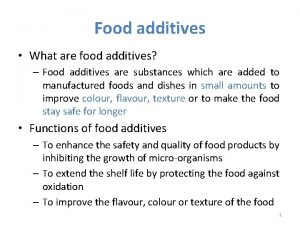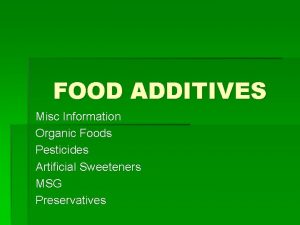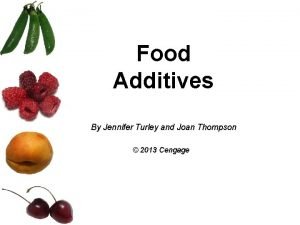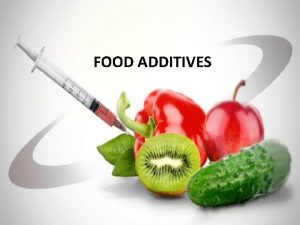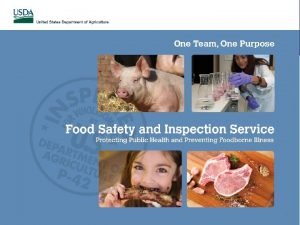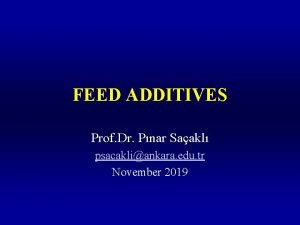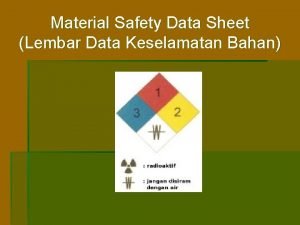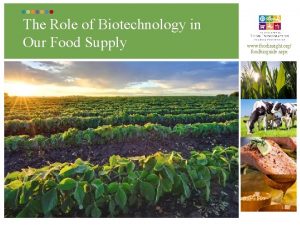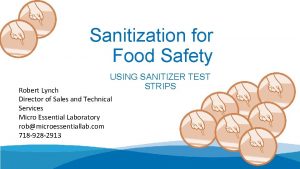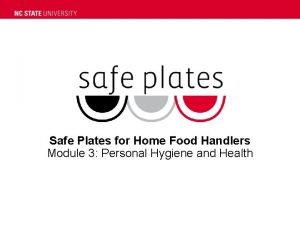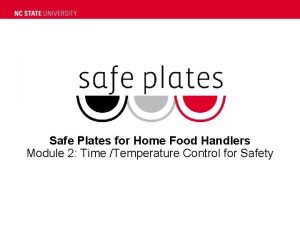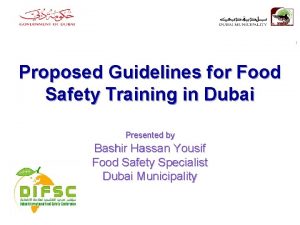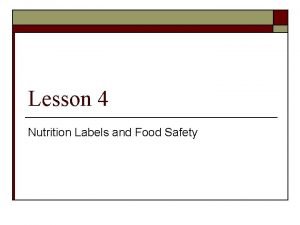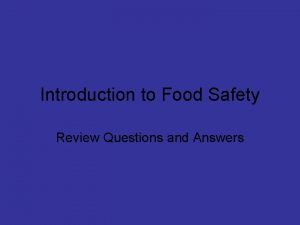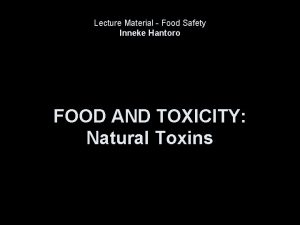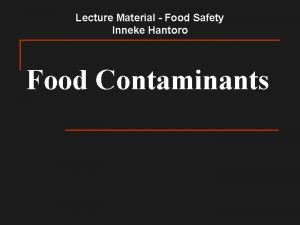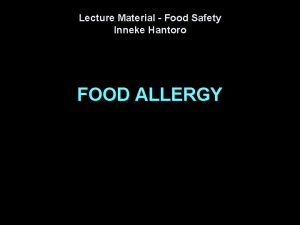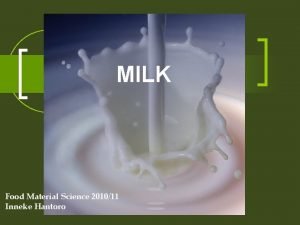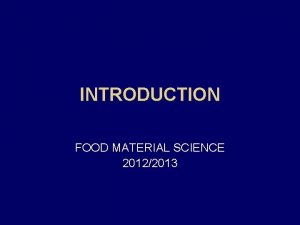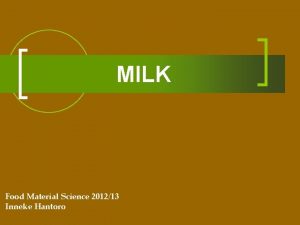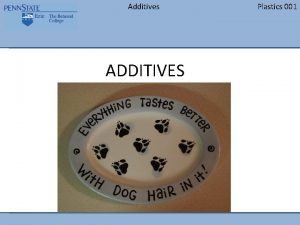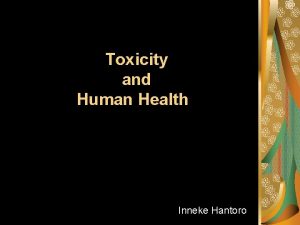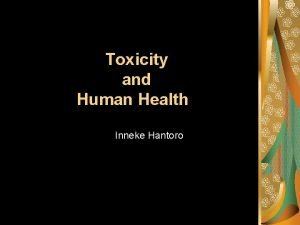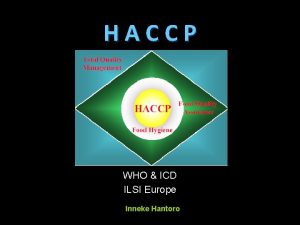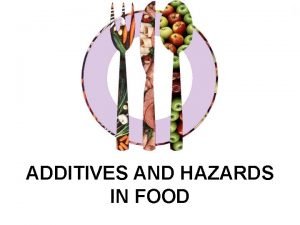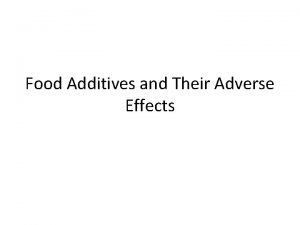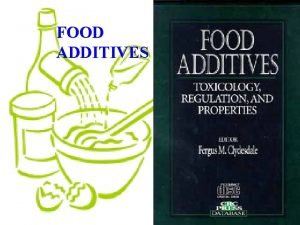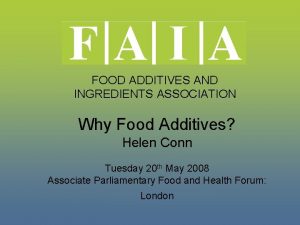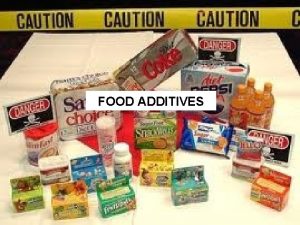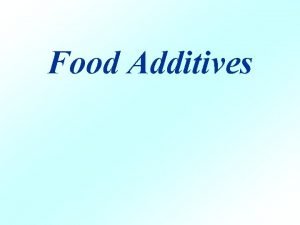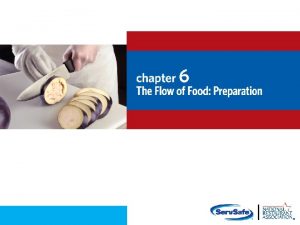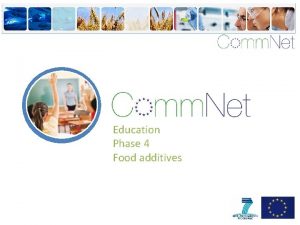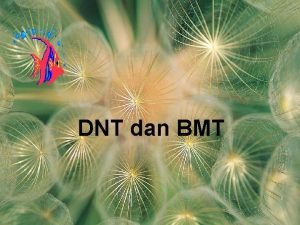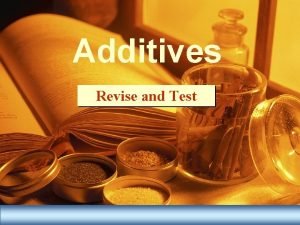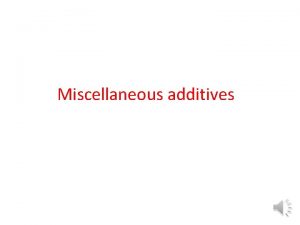Lecture Material Food Safety Inneke Hantoro FOOD ADDITIVES







































- Slides: 39

Lecture Material - Food Safety Inneke Hantoro FOOD ADDITIVES Direct & Indirect Chemical Residues

Definition • Any substance added to food during production, processing, treatment, packaging, transportation or storage. • In legally term, it defined as “ any substance the intended use of which results or may reasonably be expected to result directly or indirectly in its becoming component or otherwise affecting the characteristics of any food” (FDA/IFIC, 1992).

• Direct additives are added to a food for a specific purpose and are identified on the ingredient label of the food. • Indirect additives unintentionally become part of the food in trace amount due to its handling, packaging, etc. • Excessive levels of an additive or inclusion of an undeclared additive may be directly dangerous in some instances.

Migration of Packaging • Plastic consists of its polymer, plasticizers, antistatic agents, stabilizers and antioxidants, etc. • Some components are more likely to migrate into foods than others, esp. residual plastic monomers and plasticizers. • The plastic monomers of most health concern are vinyl chloride, and styrene.

1. Vinyl Chloride Monomer (VCM) • The monomer of polyvinyl chloride (PVC). • It leaches into both water and fats. • Typical products that absorb VCM are bottled mineral water and cooking oils. • Mineral water (stored in PVC bottles) has been shown to take up VCM. After 6 months, a concentration of 170 mg/l was measured. • This may lead to a daily intake of 120 ng person in countries where PVC bottled drinking water is used. • In cooking oils, higher concentrations have been found, 14. 8 mg/kg.

• It also the most available for migration from the ‘cling films’ that are used for all kinds of foods. • Vinyl chloride has been identified as a liver carcinogen in animal models as well as in humans. • Acute intoxication causes depression of the central nervous system and hepatic damage.

2. Styrene • While paper and board materials may transmit taint or odor to a food, plastics have a much greater potential to do this. • These taints may be residual monomer e. g. styrene. This is probably the compound usually responsible when consumers detect a 'plastic taste' in a food • Styrene prefers to leach into fats. • Typical sources of styrene: deli packaging (sausages, ham, smoked beef/ bacon/ fish, etc) and yoghurt cups. • It is a potent mutagen.

• Styrene-induced toxic effects include renal and hepatic damage, pulmonary edema, and cardiac arrhythmia. The oral LD 50 in rats is relatively low is 5 g/kg. • Average concentrations of 27 ppb have been measured in high-fat yogurt, 71 ppb in fruit yogurt, 20 to 70 ppb in other desserts, 18 to 180 ppb in meat products and 5 ppb in packed fruit and vegetable salads. • For styrene, a provisional ADI of 40 ng/kg has been calculated.

3. Plasticizers • Important plasticizers in PVC plastics are the phthalic acid esters di-(2 - ethylhexyl) phthalate (DEHP) and din-butyl phthalate (DBP). • The phthalic acid esters DEHP and DBP have low acute toxicities. • However, liver or lung damage by the leached plasticizers has been suggested. DEHP and DBP appear to be non-genotoxic carcinogens. • Since they are widely distributed in materials involved in transportation, construction, clothing, medicine, and packaging, the concern about their health effects has increased.

• Different plastics and forms are designed for specific product containment situations. • Use of this plastic packaging in a manner other than that for which it was designed may cause significant migration of plastic compounds into the food.

Situation that can promote contaminants migration: • Heating containers (by microwave oven) which are designed solely for chilled foods. • Overheating ‘heat resistant’ containers. • Coming close to laminating leftovers covered with cling wrap in the microwave. Following the instruction on the label / packaging is important!

Nitrates, Nitrites, and N-nitroso compounds • Nitrates (NO 3) and nitrites (NO 2) are used to preserve meat products, such as bacon, ham, hot dogs, and cold cuts. • The addition of nitrite can give desirable color to meat products (pink) and flavor, retards fat oxidation, and prevent bacterial growth (especially Clostridium botulinum). • Nitrites was intentionally added to meat in the 16 th or 17 th century.

1. Nitrites • Nitrite inhibits the bacterial production by inhibiting certain enzymes within the microbe and on its cell membrane. • Nitrite weakens the bacterial spores, reducing the like-hood of germination. • Nitrite is very reactive and can be directly toxic or form carcinogenic N-nitroso compounds. • It can oxidize blood oxyhemoglobin (ferrous form) to methemoglobin (ferric form).

• Oxyhemoglobin is a good transport for oxygen throughout the body, while oxygen can’t bind to methemoglobin unavailable for respiration. • Excessive nitrite intake can lead to cyanosis and suffocation. • The average lethal dose of nitrite is approx. 4 g as sodium nitrite. • The sub-lethal doses of nitrite may lead to abnormalities in metabolism of the body.

• When nitrite is acidified to nitric oxide, it provides antimicrobial activity. • If it reacts with amines under acidic conditions, carcinogenic nitrosamines may be formed. • The residual amounts of nitrites in various meat products should not exceeded 100 mg/kg, or 50 mg/kg for dried meat products, and 175 mg/kg for cured bacon. • ADI for nitrites expressed as sodium nitrites is 0. 1 mg/kg body weight.

2. Nitrates • Commonly found in water and vegetables, especially those grown with high-nitrate fertilizer. • It has low reactivity not toxic. • However, nitrate becomes a hazard when it is reduced to nitrite! Dietary nitrates can be converted to nitrites during digestion. • Cases of life-threatening methemoglobinemia when the patient’s diet contained too many nitrate sources (e. g. drinking water and spinach) within a short time span. • 5% of ingested nitrates in saliva is reduced to nitrite by bacteria.

3. N-nitroso compounds • There are 2 types: nitrosamines & nitrosamides. • They are formed when a nitroso group replaces a hydrogen attached to a nitrogen nitrosation. • The formation of these compounds is encouraged at high temperature and can be catalyzed directly by stomach acid or bacteria. • Nitrosamines are generally stable and can be quickly distributed through the body, although need metabolic activation for mutagenic and carcinogenic activity.

• Nitrosamines are found in cured meat products and malt products (beer). • Another case: nitrosamine in rubber baby bottle nipples! • Nirosamides are direct mutagen. • They can be decomposed at mild alkaline condition or destroyed by cooking. • The mutagenic/carcinogenic potential of nitroso compounds in animal models is well documented, but the toxicity to humans is not proven.

• Exposure to nitroso compound can be minimized as contaminants by using ascorbic and erythorbic acids in curing solutions, which have synergistic effect on nitrite. • The level of sodium ascorbate is 550 ppm together with sodium nitrite (100 -200 ppm) in bacon product (USFDA). • If sugar and LAB are also added, the amount of nitrite used is about 40 ppm.

• The max limit of nitrosamine allowed in fried bacon is 10 ppb (USFDA). • Nitrite in smoked fish should be monitored as well at least 100 ppm in vacuum packed smoked fish to prevent botulism, but should also be less than 200 ppm to prevent nitrite poisoning.

Sulfites • Sulfites (SO 3) are used as antioxidants to prevent enzymatic browning, inhibit bacterial growth (in wine), bleaching agent, dough conditioner, to prevent melanosis on shrimp, and in the production of some food packaging. • They are present in the form of sulfur dioxide, sodium sulfite, sodium metabisulfite, sodium bisulfite.

• Individuals with asthma problem are sensitive to sulfites. • GRAS (Generally Recognized As Safe) since 1959, but then they are banned by FDA (1986) after reported causing some health problems when they used to maintain the color and crispness of the salad greens. • Sulfites sprayed onto foods produce the most rapid allergic reactions. • Sulfites can destroy thiamin banned by FDA to be used in important sources of the vitamin (e. g. enriched flour).

• FDA requires that product labels declare sulfites in excess of 10 ppm (detected level). • Sulfites are not permitted to be used in meats. • Their limit in shrimp is 100 ppm. • The major food groups contributing to dietary intake of sulphites consist of a wide variety of foods and soft drinks (dried fruit 600– 2000 mg/kg; lime and lemon juice, ‘barley water’ 350 mg/kg; concentrated grape juice 2000 mg/kg; beer and cider 20– 200 mg/kg; wines 200– 260 mg/kg).

• The ADI for sulphites (expressed as sulphur dioxide) is 0. 7 mg/kg body weight. • Unpackaged food in bulk form should have a sign stating that sulfites were used. • Case sulfite poisoning in US (1997), canned tuna contained sulfites (not declared on the label) sulfites were identified from one of the ingredients – the hydrolyzed vegetable protein (used as flavor enhancer).

Phenolic Antioxidants • They are used to protect fats against oxidation. • Butylated hydroxytoluene (BHT) and butylated hydroxyanisole (BHA) are radical scavenger. • They interfere propagation step during lipid peroxidation. • Curiously, these antioxidants can exhibit both antitumorigenic and tumorigenic effects, and they are known to alter enzyme activity affecting detoxification of xenobiotics.

• BHA and BHT have low acute toxicity. • They are categorized as GRAS in FDA. • In 1980’s BHA was suspected to have carcinogenic potential in animals and to be nongenotoxic should have a threshold dose. • BHT metabolism is more complex and slower than BHA. It is reported to have toxic effects on organ systems. • However, BHA and BHT are still permitted to be used in food 0. 02% (200 ppm) of the fat oil content of the food product or 50 ppm (combined BHA and BHT) if they are used dry low-fat product.

Salts • An important food additive for prevention of bacterial growth, for necessary technical reason, or flavor. • The chemical name for salt, sodium chloride, reveals that sodium is in fact a component of salt. By weight, salt is composed of 40% sodium and 60% chloride. One teaspoon of salt weighs 5 grams and contains about 2, 300 mg of sodium. • Both sodium and chloride ions are important in physiological processes, but excess sodium directly cause hypertension (high blood pressure), a major risk factor for heart disease, stroke and kidney disease.

• The typical modern consumption of sodium is 10 -20 times the amount needed for physiological balance. • Potassium containing table salt substitutes can cause hyperkalemia in high dose. • FDA limit sodium to 2400 mg daily for a 2000 - calorie diet. • The best way to reduce salt intake: read labels and make educated choices!

Sodium labelling defined by FDA: • Sodium free or salt free: Less than 5 mg per serving • Very low sodium: 35 mg or less of sodium per serving • Low sodium: 140 mg or less of sodium per serving • Low sodium meal: 140 mg or less of sodium per 3 ½ oz • Reduced or less sodium: At least 25% less sodium than the regular version • Light in sodium: 50% less sodium than the regular version • Unsalted or no salt added: No salt added to the product during processing

Nonnutritive sweeteners • Low calorie sweeteners, such as saccharin, aspartame, acesulfame. Saccharin • It is 300 times sweeter than sugar. • It is not metabolized no calories. • It comes in the forms of pure saccharin, ammonium saccharin, calcium saccharin, and sodium saccharin.

• Saccharin has low direct toxicity has a threshold. • It was allowed to be used in beverage additive at not more than 12 mg/fluid ounce, not more than 30 mg per serving as processed food additive. • ADI for saccharin is 2. 5 mg/kg body weight. • But it has been implicated as a potential human carcinogenic (since 1981), then it was de-listed as a safe food additive.

• In April 2000, saccharin was de-listed as a possible human carcinogen due to the lack of data in humans suggesting a carcinogenic hazard. • This decision caused a controversy. Another source stated that saccharin correlated bladder cancer. • Saccharin-containing products are still required to have warning statement on their labels.

Aspartame • Approved in 1981 as artificial sweetener. • It is 200 times sweeter than sugar and has the same number of calories per teaspoonful. • Aspartame is a dipeptide consisting of L-aspartic acid and the methyl ester of L-phenylalanine. • It can be hydrolyzed into aspartic acid, phenylalanine and methanol during digestion. • Chronic methanol exposure can cause visual impairment.

• Phenylalanine can interfere with amino acid transport and lead to nervous system disturbances only a problem in people with the rare genetic disease phenylketonuria (PKU) – unable to metabolize phenylalanine properly. • When aspartame containing product are heated or stored for a long period, aspartame can be decomposed into diketopiperazine (DKP), a tumor agent. • ADI for DKP is 30 mg/kg bw. • ADI for aspartame is 50 mg/kg bw. • In ready to bake product aspartame is limited to 0. 5% by weight.

Stevioside • A natural sweetener from Stevia rebuadiana plant. • It is 200 -300 times sweeter than sugar and have no calories. • It was used as a common sweetener in Japan (herbal teas) during 1980’s. • It was banned in 1991 because of the lack of formal toxicological evaluation proving its safety. • It is not allowed in Canada and some EU. • Some current studies indicate that steviol, a metabolite of stevioside may have toxic effect (EC). • Ironically, stevia is allowed as a nutritional supplement (FDA Import Allert 45 -06, 1996).

Color additives • FD&C color safe for foods, drugs and cosmetics. • Certified color belong to four classes: azo dyes, triphenylmethane dyes, xanthene dyes and sulfonated indigo dyes. • They should be used at less than 300 ppm, according to GMP it is still too high considering the tolerances of other chemical residues!

• Some colorants have been de-listed due to their carcinogenic potential, such as: - FD&C Red No. 1 hepatocarcinogenic - FD&C Red No. 2 still used in developing countries (insufficient toxicological evidence to human health) - FD&C Red No. 4 originally margarine/butter colorant, delisted in 1976 due to its toxicity. - FD&C Red No. 40 allowed in US but not in some European countries. - Citrus Red No. 2 only allowed for coloring orange skins, implicated as animal carcinogen. - FD&C Yellow No. 3 and No. 4 originally used as margarine colorants, delisted in 1959 due to hepatotoxicity.

- Yellows No. 5 (tartrazine) and 6 (sunset yellow) are associated with allergic reactions and specifically required to be declared on ingredient labels. - Orange B is permanently listed, but is restricted to be used on the surfaces of sausage casings at level of no more than 150 ppm.

Reference • Schmidt, R. H. & G. E. Rodrick. (2003). Food Safety Handbook. John Wiley & Sons Inc. New Jersey. • Wood R. , L. Foster, A. Damant & P. Key. (2004). Analytical Methods for Food Additives. CRC Press. Boca Raton.
 Ve inneke ala hulukin azim
Ve inneke ala hulukin azim Food additives examples
Food additives examples Msg pesticide
Msg pesticide Examples of intentional food additives
Examples of intentional food additives Natural and artificial food additives
Natural and artificial food additives Food technology revision
Food technology revision Substance added to food
Substance added to food 01:640:244 lecture notes - lecture 15: plat, idah, farad
01:640:244 lecture notes - lecture 15: plat, idah, farad The monophasic liquid dosage form is ……. solutions
The monophasic liquid dosage form is ……. solutions Example of plasticizer
Example of plasticizer Food safety and inspection service definition
Food safety and inspection service definition Feed additives classification
Feed additives classification High performance additives
High performance additives Colors of regulation
Colors of regulation What is food safety
What is food safety Gd &t symbols
Gd &t symbols Time variance
Time variance Cultural relativism
Cultural relativism Material and non material culture examples
Material and non material culture examples All groups create norms to enforce their cultural values.
All groups create norms to enforce their cultural values. Harmful or useful
Harmful or useful Potential hazards
Potential hazards Contoh material safety data sheet
Contoh material safety data sheet Unit 2 food food food
Unit 2 food food food Food chain sequence
Food chain sequence What is catzoc
What is catzoc Safety care certification
Safety care certification Process safety vs personal safety
Process safety vs personal safety Ind safety report
Ind safety report Basic safety (construction site safety orientation)
Basic safety (construction site safety orientation) Basic safety construction site safety orientation
Basic safety construction site safety orientation Biotechnology and food safety
Biotechnology and food safety Savvy food safety
Savvy food safety Test strips for food safety
Test strips for food safety Henss food safety stand for
Henss food safety stand for Tcs in food safety
Tcs in food safety Safety management system template
Safety management system template Food hygiene training in dubai
Food hygiene training in dubai Datingoo
Datingoo Food safety questions and answers
Food safety questions and answers

